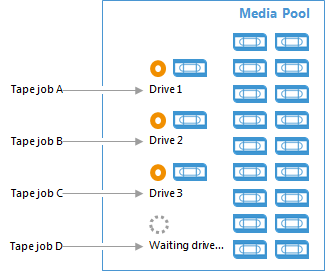If your tape library has multiple drives, you can use drives simultaneously for writing data to tape. This option is useful if you have a lot of tape jobs running at the same time or you have a lot of data that must be written to tape in a limited backup window.
Tape parallel processing is enabled on the Options step of the Media Pool wizard. In the media pool settings, you can set the maximum number of drives that the media pool can use simultaneously.
|
You cannot enable parallel processing for GFS media pools. |
When you process tape jobs parallely, the media pool assigns a drive to each running tape job. The media pool can use the predefined maximum number of drives and process the equal number of tape jobs simultaneously. For example, if you set 3 drives as the maximum, you can process up to 3 tape jobs at the same time. If you have more jobs running at the same time, they are queued. When one of the jobs finishes and releases its drive, the first queued job takes the drive.
For example:
- You set the maximum number of drives to 3.
- 4 tape jobs start at the same time.
The tape jobs start, and 3 of them occupy 3 drives to write data to tape. The Tape job D is queued and waits. When one of the jobs finishes and releases its drive, the Tape job D takes the drive and starts writing data.








